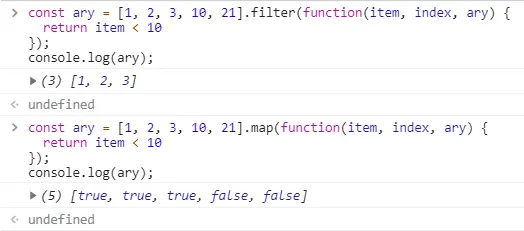
字符串与数组
方塘禾丰[TOC]
一、字符串操作
切割、合并、截取
split
函数:String.split(separator, ?limit)
功能:使用一个指定的分隔符把一个字符串分割存储到数组
1 | const str = 'jpg|bmp|gif|ico|png'; |
concat
函数:String.concat(…strings)
功能:将多个字符串依次并在String的后面
1 | 'start'.concat(', ', 'hello', ' world') // start, hello world |
slice、substring、substr比较
函数:String.slice(start, ?end)
start:必填。指定子字符串开始位置,默认为0。可以为负数,-1表示最后一位,-2表示倒数第二位。
end:可选。指定子字符串结束位置,可以为负数。如果未指定此参数,则表示从start到字符串结束的子字符串。
return:返回子字符串,包含从start到end-1的所有字符,长度 为“end减start”,即“包前 不包后”!
函数:String.substring( start, ?end)
start:必填。非负整数,指定子字符串开始位置。如果start为负数,自动替换为0
end:可选。非负整数,指定子字符串结束位置。如果end为负数,自动替换为0
return:返回子字符串,包含从start到end-1的所有字符,长度 为“end减start”,即“包前 不包后”!
如果start比end大,那么会先交换两个参数再截取字符串
函数:String.substr( from, ?length)
from:必填。指定子字符串开始位置。可以为负数,-1表示最后一位,-2表示倒数第二位。
length:可选。待选取字符串的长度。0或负数返回空字符串,不指定,则子字符串延续到字符串的最后。
return:返回子字符串,包含从start起,截取的length长度的字符串。
1 | '012345'.slice() // 012345 |
小结:
- slice, substring根据位置截取字符串;substr根据长度截取。
- substring的start/end的有效值为非负整数,slice的start/end, substr的from可以为负数。
- 第二个参数不提供(end, length),则截取到字符串末尾。
- 只有substring会 根据大小自动调整start, end的先后,以截取到有效字符串。
查找替换
indexOf、lastIndexOf
函数:String.indexOf(searchString, ?position), String.lastIndexOf(searchString, ?position)
功能:indexOf从字符串开始位置向后 查找指定字符串的位置,lastIndexOf相反,从字符串尾部向前查找
1 | 'hello world'.indexOf('o') // 4 |
charAt
函数:String.charAt(index)
功能:返回指定位置的字符。字符串中第一个字符的下标是0。如果参数 index 不在 0 与 string.length 之间,该方法将返回一个空字符串’’若通过String[索引]方式查找不到 目标字符,返回的是undefined
1 | '0123456'.charAt(4) // 4 |
charCodeAt
函数:String.charCodeAt(index)
功能:返回 指定位置 字符 在 Unicode字符集上对应 码点的 十进制值(相当于下面String.fromCharCode() 的逆操作!)。这个返回值是 0 - 65535 之间的整数。如果参数 index 不在 0 与 string.length 之间,该方法将返回NaN。
注意,charCodeAt 方法返回的 Unicode 码点不会大于 65536(0xFFFF),也就是说,只返回两个字节的字符的码点。如果遇到码点大于 65536 的字符(四个字节的字符),必需连续使用两次 charCodeAt,不仅读入charCodeAt(i),还要读入 charCodeAt(i+1),将两个值放在一起,才能得到准确的字符。
拓展:或者直接使用codePointAt() ,codePointAt() 可以 返回 大于 0xFFFF (65535) 的 Unicode 值的完整值。
1 | '0123456'.charCodeAt(4) // 52'0123456'.charCodeAt(-1) // NaN |
fromCharCode
函数:String.fromCharCode(n1, n2, …, nX)
功能:可接受一个指定的 Unicode 值,然后返回一个字符串。
1 | var n = String.fromCharCode(72,69,76,76,79);//HELLO |
replace
函数:String.replace(searchValue, replaceValue)
1 | 'bone, alone, phone'.replace('one', 1) // b1, alone, phone |
trim
函数:String.trim()
功能:去除字符串首尾空格
trim在ES5已定义,且大多数浏览器已支持,不再需要自己实现。详见:trim on MDN
1 | 'hello'.trim() // 'hello' |
字符串操作 其它方法
strartsWith/endsWith
函数:String.strartsWith()/String.endsWith()。功能:判断 字符串首、尾是否以 目标子字符串 开头、结尾。返回boolean值。
toUpperCase/toLowerCase
函数:String.toUpperCase()/String.toLowerCase()。功能:字母转大、小写。
注意:
通过对 string[索引] 赋值方式,并不能改变 目标string,只能对 新变量 并进行赋值才能改变。要与数组操作区分开!!!
二、数组操作
数组整体 操作
join
函数:Array.join(?separator)
功能:通过指定的分隔符将数组项连接合并为一个字符串,参数不传则默认为”,”
1 | const arr = ['jpg', 'bmp', 'gif', 'ico', 'png'] |
reverse
功能:将函数项颠倒顺序,会改变 原数组
1 | const ary = [1, 2, 3] |
concat
功能:将多个数组合并,不改变原数组
1 | const ary = ['cat'] |
数组项 操作
(3种 查找 数组元素的方法:includes、indexOf/lastIndexOf、Array.find/Array.findIndex。前2种也适用于 查找字符串!!)
includes
用处:判断 数组 是否包含 指定的元素。或者 字符串 是否包含指定的 子字符串。返回boolean值
indexOf, lastIndexOf
功能:indexOf(searchElement, position),searchElement为需要查找的元素,position为开始查找的位置。
从前往后查找满足条件的 第一项索引,找到了就返回该索引,找不到 返回-1。lastIndexOf相反。
1 | const ary = ["cat", "hat", "cat", "fat"] |
Array.find
遍历数组中的元素,找到满足条件的元素,就返回 第一个 满足该条件元素的 值;找不到,就返回undefined。
有3个参数。item:每一次迭代查找的数组元素。index:每一次迭代查找的数组元素索引。array:被查找的数组。
1 | const arr = [1, 2, 6, 5, 12]; |
Array.findIndex
遍历数组中的元素,找到满足条件的元素,就返回 第一个 满足该条件元素的 索引;找不到,就返回-1。三个参数同上!
1 | const arr = [1, 2, 6, 5, 12]; |
拓展:
findIndex 与 indexOf 的主要区别在于 findIndex 接受回调作为参数,而 indexOf 接受值作为参数。
这意味着 indexOf 只会在数组中查找值,而 findIndex 将让你 决定如何查找索引。
查找数组中是否存在 某元素,是使用 findIndex 还是 indexOf ????
若要查找的数组元素是 基本类型,两种方法没有区别。
若要查找 数组中 对象 的索引,会有什么差别吗???
正如在 indexOf 中看到的那样,即使我们提供了一个相同的对象,但没有指向同一个引用,它也无法在数组中找到它。
使用 findIndex 允许我们检查数组中每个对象的属性、键和值,因此它可以在数组中找到正确的项目并返回索引。
最后,因为我们把引用传递给最后一个 indexOf 方法,它可以在数组中找到正确的项,因为引用相等。
结论:如果你正在搜索更复杂的值(例如对象),请使用Array.prototype.findIndex 以便你可以通过搜索每个对象的键、值和属性来找到正确的索引。
push
功能:数组尾部插入一个项,会改变原数组。返回值为插入后的 数组长度。
const ary = [‘head’, ‘tail’]
const length = ary.push(‘hello’)
console.log(ary) // [‘head’, ‘tail’, ‘hello’]console.log(length) // 3
pop
功能:数组尾部移除一个项,会改变原数组。返回值为移除的项。
const ary = [‘head’, ‘tail’]
const item = ary.pop()
console.log(ary) // [‘head’]
console.log(item) // ‘tail’
unshift
功能:数组头部插入一个项,会改变原数组。返回值为插入后的 数组长度。
const ary = [‘head’, ‘tail’]
const length = ary.unshift(‘hello’)
console.log(ary) // [‘hello’,’head’, ‘tail’]
console.log(length) // 3
shift
功能:数组头部移除一个项,会改变原数组。返回值为移除的项。
const ary = [‘head’, ‘tail’]
const item = ary.shift()
console.log(ary) // [‘tail’]
console.log(item) // ‘head’
slice
函数:Array.slice(?start, ?end)
功能:数组项的截取,返回一个 新数组。不改变 原数组!!!!!
1 | const ary1 = [0,1,2,3,4,5].slice() // [0,1,2,3,4,5] |
splice
函数:Array.splice(start, ?deleteCount, …items)
功能:可以对数组进行添加删除,间接实现替换功能。会改变原数组。
1 | let ary = [0, 1, 2, 3, 4, 5] |
迭代操作
sort
功能:默认 按照数组项的字符的unicode排序,如果不是字符串,调用toString转为字符串。
1 | const ary = [1, 2, 10, 3] |
用法:数字的升、降序 [只适用于 数字间,不适用ascii比大小]
1 | // 升序 |
for…in…
for(var index in Array)
index 为Array中的 索引。【访问 数组元素 使用array[index]】
补充:数组作为一个对象,为避免遍历其原型链上的 一些共有属性。可能会需要Reflect.ownKeys(arr)或Object.getOwnPropertyNames(arr)。返回所有自有属性key,不管是否可枚举,但不包括 继承自原型的属性。
for(var key in Object)
index 为Object中的 key【访问 对象的值 使用object[key],其中key是string类型;遍历对象的可枚举属性,包括自有属性、继承自原型的属性】
for…of…
for(var item of Array/String/map/set等拥有迭代器对象的集合,不能遍历 对象)
item 为Array中的 元素,或String中的 字符。
forEach
功能:数组遍历,没有返回值。无法响应break、continue和return语句,直至遍历结束。
[‘a’, ‘b’, ‘c’].forEach(function(item, index, array) {
console.log(item, index, array)
// a 0 [‘a’, ‘b’, ‘c’];
// b 1 [‘a’, ‘b’, ‘c’];
// c 2 [‘a’, ‘b’, ‘c’];
})
map
功能:遍历数组各项,并 返回一个 新数组【数组被处理后,数组长度 不变,但元素本身 可能发生改变】
const ary = [‘a’, ‘b’, ‘c’].map(function(item, index, ary) {
return item.charCodeAt(0)
})
console.log(ary) // [97, 98, 99]
filter
功能:遍历数组各项,根据判断条件,过滤出(返回)符合条件的元素 所组成的数组【元素个数 可能少于原数组,但 不改变元素本身】
const ary = [1, 2, 3, 10, 21].filter(function(item, index, ary) {
return item < 10
})
console.log(ary) // [1, 2, 3]
filter 与 map的简单比较:
every, some
功能:
(注意:[].every(ele => {return ele}),整体返回true)
对于一个 [],在 [] 中,没有任何元素 违反了 判断条件,因此 .every() 方法会直接返回 true。
1 | let res = [1, 2, 3, 10, 21].every(function(item, index, ary) { |
reduce, reduceRight
具体用法详见:JS Array.reduce 理解与使用 - 简书
函数:array.reduce(function(total, currentValue, currentIndex, arr), initialValue)
功能:聚合数组项,根据聚合函数生成最后结果。当没有指定initialValue时,reduce从第一个元素开始,从左向右聚合,reduceRight相反。【total为上次循环的 结果集,currentValue为array遍历的当前项】
1 | let res = [1, 2, 3, 4, 5].reduce(function(a, b) { |
小结
会改变 原数组的操作:reverse, sort, splice, push, pop, shift, unshift
三、字符串 与 数组 的一些同名操作
slice
const str = ‘012345’.slice(1,3) // ‘12’
const ary = [0,1,2,3,4,5].slice(1,3) // [1,2]
concat
const str = ‘start’.concat(‘, ‘, ‘hello’, ‘ world’) // start, hello world
const ary = [‘start’].concat([‘,’, ‘ hello’], [‘world’]) // [‘start’, ‘,’, ‘ hello’, ‘world’]
includes
用处:判断 数组 是否包含 指定的元素。或者 字符串 是否包含指定的 子字符串。返回boolean值
arr = [1, 2, 3, 4];
str = ‘sdfga’;
console.log(arr.includes(2));//true
console.log(arr.includes(6));//false
console.log(str.includes(‘df’));//true
console.log(str.includes(‘h’));//false
indexOf, lastIndexOf
const index1 = ‘hello world’.indexOf(‘o’) // 4
const index2 = [‘hello’,’world’].indexOf(‘world’) // 1
const index3 = ‘hello world’.lastIndexOf(‘o’) // 7
const index4 = [‘hello’,’world’].lastIndexOf(‘world’) // 1











